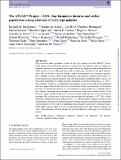The Atlas3D Project - XXX. Star formation histories and stellar population scaling relations of early-type galaxies
Abstract
We present the stellar population content of early-type galaxies from the ATLAS3D survey. Using spectra integrated within apertures covering up to one effective radius, we apply two methods: one based on measuring line-strength indices and applying single stellar population (SSP) models to derive SSP-equivalent values of stellar age, metallicity, and alpha enhancement; and one based on spectral fitting to derive non-parametric star formation histories, mass-weighted average values of age, metallicity, and half-mass formation time-scales. Using homogeneously derived effective radii and dynamically determined galaxy masses, we present the distribution of stellar population parameters on the Mass Plane (MJAM, σe, Rmaje), showing that at fixed mass, compact early-type galaxies are on average older, more metal-rich, and more alpha-enhanced than their larger counterparts. From non-parametric star formation histories, we find that the duration of star formation is systematically more extended in lower mass objects. Assuming that our sample represents most of the stellar content of today's local Universe, approximately 50 per cent of all stars formed within the first 2 Gyr following the big bang. Most of these stars reside today in the most massive galaxies (>1010.5 M⊙), which themselves formed 90 per cent of their stars by z ∼ 2. The lower mass objects, in contrast, have formed barely half their stars in this time interval. Stellar population properties are independent of environment over two orders of magnitude in local density, varying only with galaxy mass. In the highest density regions of our volume (dominated by the Virgo cluster), galaxies are older, alpha-enhanced, and have shorter star formation histories with respect to lower density regions.
Citation
McDermid , R M , Alatalo , K , Blitz , L , Bournaud , F , Bureau , M , Cappellari , M , Crocker , A F , Davies , R L , Davis , T A , de Zeeuw , P T , Duc , P-A , Emsellem , E , Khochfar , S , Krajnovic , D , Kuntschner , H , Morganti , R , Naab , T , Oosterloo , T , Sarzi , M , Scott , N , Serra , P , Weijmans , A-M & Young , L M 2015 , ' The Atlas 3D Project - XXX. Star formation histories and stellar population scaling relations of early-type galaxies ' , Monthly Notices of the Royal Astronomical Society , vol. 448 , no. 4 , pp. 3484-3513 . https://doi.org/10.1093/mnras/stv105
Publication
Monthly Notices of the Royal Astronomical Society
Status
Peer reviewed
ISSN
0035-8711Type
Journal article
Description
MC acknowledges support from a Royal Society University Research Fellowship. This work was supported by the rolling grants ‘Astrophysics at Oxford’ PP/E001114/1 and ST/H002456/1 and visitor grants PPA/V/S/2002/00553, PP/E001564/1, and ST/H504862/1 from the UK Research Councils. RLD acknowledges travel and computer grants from Christ Church, Oxford and support from the Royal Society in the form of a Wolfson Merit Award 502011.K502/jd. TN acknowledges support from the DFG Cluster of Excellence Origin and Structure of the Universe. MS acknowledges support from an STFC Advanced Fellowship ST/F009186/1. TAD acknowledges the support provided by an ESO fellowship. The research leading to these results has received funding from the European Community's Seventh Framework Programme (/FP7/2007-2013/) under grant agreement No. 229517. The authors acknowledge financial support from ESO. SK acknowledges support from the Royal Society Joint Projects Grant JP0869822. NS acknowledges support of Australian Research Council grant DP110103509Collections
Items in the St Andrews Research Repository are protected by copyright, with all rights reserved, unless otherwise indicated.
Related items
Showing items related by title, author, creator and subject.
-
SDSS-IV MaNGA: How the stellar populations of passive central galaxies depend on stellar and halo mass
Oyarzún, Grecco A.; Bundy, Kevin; Westfall, Kyle B.; Tinker, Jeremy L.; Belfiore, Francesco; Argudo-Fernández, Maria; Zheng, Zheng; Conroy, Charlie; Masters, Karen L.; Wake, David; Law, David R.; McDermid, Richard M.; Aragón-Salamanca, Alfonso; Parikh, Taniya; Yan, Renbin; Bershady, Matthew; Sánchez, Sebastián F.; Andrews, Brett H.; Fernández-Trincado, José G.; Lane, Richard R.; Bizyaev, D.; Boardman, Nicholas Fraser; Lacerna, Ivan; Brownstein, J. R.; Drory, Niv; Zhang, Kai (2022-07-06) - Journal articleWe analyze spatially resolved and co-added SDSS-IV MaNGA spectra with signal-to-noise ratio ∼100 from 2200 passive central galaxies (z ∼ 0.05) to understand how central galaxy assembly depends on stellar mass (M*) and halo ... -
Secular-and merger-built bulges in barred galaxies
Mendez Abreu, Jairo; Debattista, V. P.; Corsini, E. M.; Aguerri, J. A. L. (2014-12) - Journal articleContext. Historically, galaxy bulges were thought to be single-component objects at the center of galaxies. However, this picture is now questioned since different bulge types with different formation paths, namely classical ... -
Galaxy And Mass Assembly (GAMA) : galaxy close pairs, mergers and the future fate of stellar mass
Robotham, A. S. G.; Driver, S. P.; Davies, L. J. M.; Hopkins, A. M.; Baldry, I. K.; Agius, N. K.; Bauer, A. E.; Bland-Hawthorn, J.; Brough, S.; Brown, M. J. I.; Cluver, M.; De Propris, R.; Drinkwater, M. J.; Holwerda, B. W.; Kelvin, L. S.; Lara-Lopez, M. A.; Liske, J.; Lopez-Sanchez, A. R.; Loveday, J.; Mahajan, S.; McNaught-Roberts, T.; Moffett, A.; Norberg, P.; Obreschkow, D.; Owers, M. S.; Penny, S. J.; Pimbblet, K.; Prescott, M.; Taylor, E. N.; van Kampen, E.; Wilkins, S. M. (2014-11-11) - Journal articleWe use a highly complete subset of the Galaxy And Mass Assembly II (GAMA-II) redshift sample to fully describe the stellar mass dependence of close pairs and mergers between 10(8) and 10(12)M(circle dot). Using the analytic ...

